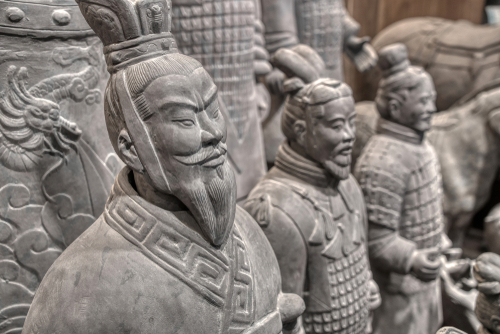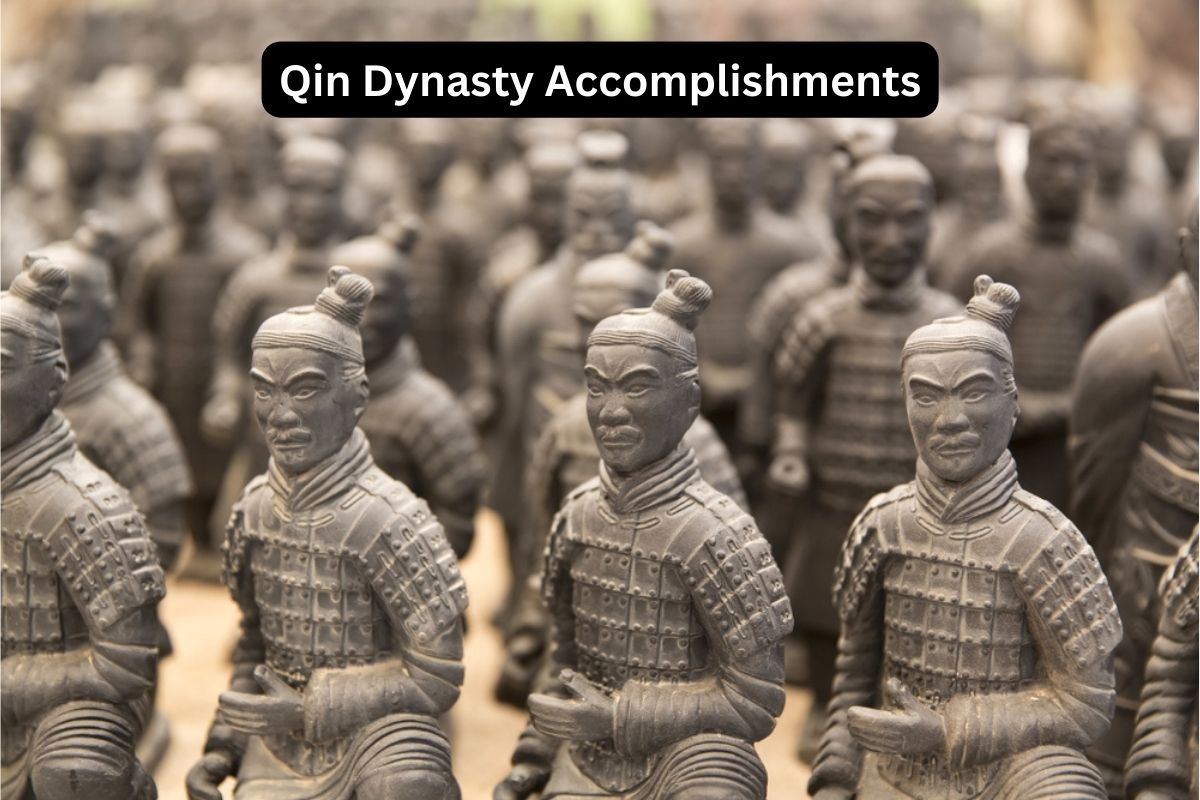The Qin Dynasty, lasting from 221 BCE to 206 BCE, was a pivotal period in ancient Chinese history. Founded by Emperor Qin Shi Huang, it brought an end to centuries of internal strife, unifying China under centralized imperial rule.
The dynasty is renowned for its remarkable achievements, including the construction of the Great Wall, the creation of the Terracotta Army, and the standardization of writing and measurements.
Despite its relatively short duration, the legacy of the Qin Dynasty profoundly shaped the course of Chinese civilization and governance for centuries to come.
Accomplishments of the Qin Dynasty
1. Unification of China
Prior to the Qin Dynasty, China was divided into several warring states, known as the Warring States period. Qin Shi Huang, the first emperor of the Qin Dynasty, successfully conquered and unified these states through a series of military campaigns.
Also Read: Facts About the Qin Dynasty
His conquests culminated in 221 BCE when he declared himself the First Emperor (Shi Huangdi) and established the Qin Dynasty. This unification brought an end to centuries of internal conflict and laid the groundwork for the subsequent centralized imperial rule of China.
2. Standardization of Writing
The Qin Dynasty played a significant role in standardizing the Chinese writing system. Before unification, different states had their own script styles and characters, making communication and administration challenging.
Also Read: Timeline of the Qin Dynasty
Qin Shi Huang’s government promulgated the use of a standardized script known as “Small Seal Script” (Xiaozhuan), which simplified and unified the characters across the empire.
This standardization enhanced cultural cohesion, improved record-keeping, and facilitated communication between different regions of China.

3. Construction of the Great Wall
Although the idea of building defensive walls to protect against northern invasions predates the Qin Dynasty, it was during this time that the various walls were connected and extended to form the Great Wall of China as we know it today.
The Great Wall served as a formidable barrier against raids and invasions by nomadic tribes from the north, such as the Xiongnu.
The massive scale of the construction showcased the engineering capabilities of the Qin Dynasty and demonstrated their commitment to defending the northern borders of China. The Great Wall stands as a symbol of China’s historical resilience and ingenuity.
4. Terracotta Army
One of the most remarkable archaeological discoveries in history, the Terracotta Army, was created during the reign of Emperor Qin Shi Huang. Around 210-209 BCE, massive underground pits were constructed near the emperor’s tomb, containing an estimated 8,000 life-sized clay soldiers, horses, and chariots.
Each figure was intricately sculpted with unique facial expressions, hairstyles, and armor, reflecting the diversity of the ancient Chinese military. The purpose of the Terracotta Army was to accompany the emperor in the afterlife and protect him.
This extraordinary artistic and engineering feat showcases the advanced level of craftsmanship and organizational skill during the Qin Dynasty.
5. Centralization of Power
The Qin Dynasty introduced a highly centralized form of government, consolidating power under the emperor’s authority. Qin Shi Huang’s government dismantled the feudal system and replaced it with a hierarchical administrative structure.
The empire was divided into provinces, prefectures, and counties, each governed by appointed officials who reported directly to the central authority. This centralization of power enabled more efficient decision-making, rapid communication, and enhanced control over the vast territory of China.

6. Standardization of Measurements and Currency
To promote consistency and facilitate trade and taxation, the Qin Dynasty standardized measurements and currency throughout the empire.
The government issued uniform weights and measures, such as length, volume, and weight, ensuring accuracy and fairness in trade and taxation.
Similarly, a standardized currency system was established, using round coins with square holes at the center, known as “ban liang” coins. This standardized currency system contributed to the development of a more stable and prosperous economy during the Qin Dynasty.
7. Legal Reforms
The Qin Dynasty implemented significant legal reforms to establish a more centralized and efficient legal system.
Qin Shi Huang sought to create a unified code of laws that applied uniformly throughout the empire, regardless of regional differences. Legalism, a philosophy that advocated strict adherence to the law and the use of harsh punishments, heavily influenced these reforms.
The system focused on imposing strict penalties for even minor offenses, aiming to deter crime and maintain social order. The legal reforms played a crucial role in consolidating the power of the central government and promoting obedience among the population.
8. Major Infrastructure Projects
The Qin Dynasty was notable for its ambitious and extensive infrastructure projects. The emperor invested heavily in the construction of roads, canals, and irrigation systems.
The construction of a vast network of roads enhanced transportation and facilitated the movement of troops and officials across the empire.
The extensive canal systems connected major rivers, providing an efficient means of transporting goods and improving agricultural irrigation. These infrastructure projects played a crucial role in stimulating economic growth and promoting stability within the empire.
9. Great Library
During the reign of Qin Shi Huang, efforts were made to preserve and systematize the historical texts and knowledge of the time. He ordered the collection and organization of various texts, including classics, historical records, and philosophical works.
These texts were housed in a grand imperial library, serving as a repository of knowledge and culture. While the library was unfortunately destroyed after the fall of the Qin Dynasty, the idea of preserving knowledge and historical records laid the foundation for the development of the imperial Chinese tradition of maintaining extensive collections of books and texts in subsequent dynasties.
10. Spread of Legalism Philosophy
The Qin Dynasty significantly promoted the philosophy of Legalism, which became the dominant ideology during its rule.
Legalism emphasized strict rule of law, the concentration of power in the hands of the ruler, and the importance of rewards and punishments in maintaining social order.
This philosophy influenced the governance of subsequent dynasties, particularly the short-lived Qin Dynasty’s successors, the Han Dynasty. However, as Legalism was known for its harshness and authoritarianism, it gradually gave way to other philosophical schools such as Confucianism during later periods.
